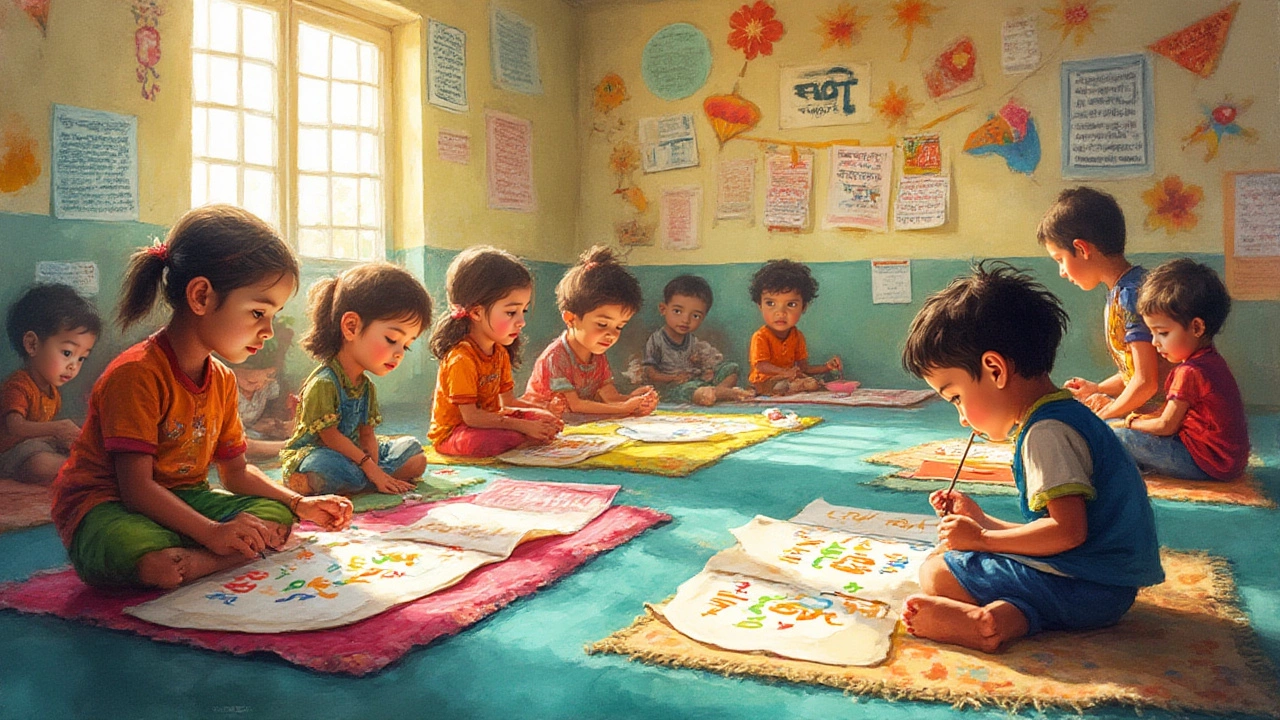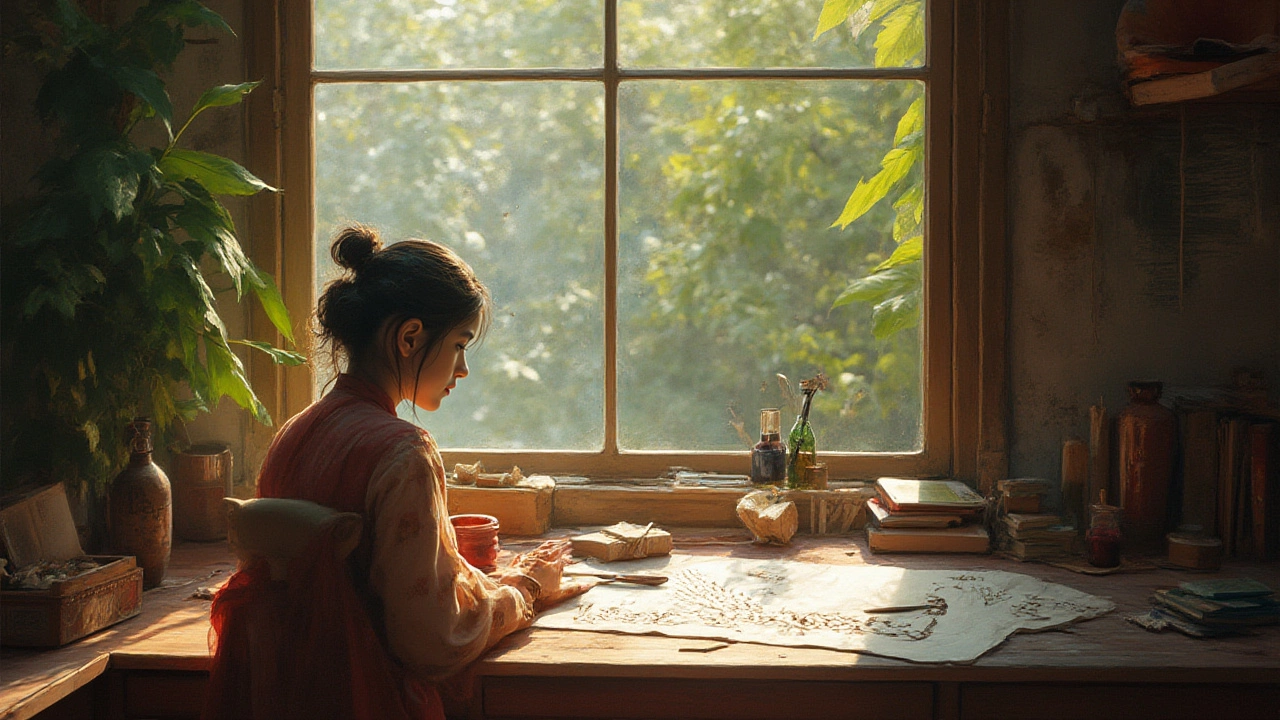
Imagine reading a poem and suddenly realizing it’s not just the words creating meaning—the way the words actually look on the page tells part of the story, too. Forget line after line in skinny columns. What if a poem looked like a tree, a running shoe, or a flying bird? That’s the world of concrete poems, where poetry isn’t just read; it’s seen. For centuries, writers have been sneaking messages into the shapes of their lines, pushing words around until reading feels like looking at a piece of art. The next time you spot a poem shaped like a heart on a Valentine’s Day card or swirling along the outline of a snail, you’re seeing a concrete poem in action.
What Is a Concrete Poem? The Heart of Visual Poetry
When most people think about poetry, they imagine rhymes, metaphors, and maybe a few flowery lines written in a notebook. Pretty classic stuff. But concrete poetry flips all that, saying, “Hey, let’s make the way a poem looks just as important as what it says.” The key idea? A concrete poem arranges its text to form a picture or a pattern that adds another layer of meaning.
The roots of concrete poetry dig surprisingly deep in history. Back in the third century BCE, Greek poet Simmias of Rhodes wrote verses shaped like wings and eggs. Fast forward, and you’ll find medieval monks drawing angels with words, or Renaissance writers making altars out of their stanzas. In every case, the writer’s trying to blend artistic design with poetry, letting the physical shape give you clues to the poem’s purpose or mood.
So, what actually makes a poem "concrete"? Here’s the trick: the poem’s arrangement on the page is absolutely essential. Without those visual cues, you’d lose the full meaning. Read a classic poem out loud, and you get most of the idea. Read a concrete poem out loud, and something’s missing—maybe a spiral that mimics a snail’s shell, or a jagged design that feels tense and sharp. Here, the concrete poem earns its title by giving words, quite literally, a body.
One of the coolest examples comes from the 20th-century Brazilian poet Augusto de Campos. In 1957, he played with the phrase “vida,” Portuguese for life, stacked it in repeating patterns so the word formed a visual pulse, like a heartbeat. This kind of thing blew open the doors for anyone who wanted to try poetry plus art, and it’s just one of thousands of examples.
Want to talk innovation? E.E. Cummings was the rebel poet who made “banana” look like bananas, used weird gaps or odd typographical choices so a poem on the page could wink at you. Now, with digital technology, concrete poets can go even bigger—some experiment with fonts, colors, or even motion in digital media. On Instagram or TikTok, visual poetry is bursting into new shapes every day, and it’s not just for “serious” writers.
| Poet | Era | Notable Work |
|---|---|---|
| Simmias of Rhodes | Ancient Greece (c. 300 BCE) | Wings, Egg-shaped Poems |
| George Herbert | 17th Century | "Easter Wings" |
| E.E. Cummings | 20th Century | Several Visual & Typographical Poems |
| Augusto de Campos | 20th Century | "Vida" |
| Mary Ellen Solt | 20th Century | "Forsythia" (flower-shaped poem) |
Even if you’re not a poet, you’ve probably run into shape poems in school or greeting cards. But don’t mistake them for a childish gimmick. They can get deep, weird, and beautifully subtle. For example, poet Mary Ellen Solt’s “Forsythia” spells a spring flower by “growing” lines outward to mimic petals. These poems may start as fun, but they pack in real emotional punch and clever word-play.

How Shape Transforms Meaning: Why Form Matters So Much
There’s something almost magical about seeing a poem shaped like what it’s describing. But it’s not just pretty—shape can totally transform how you experience a poem. When words take the shape of what they mean, your brain gets double the “aha!” moment. You understand not just because of what’s said, but because of how it looks.
If a poem about a waterfall literally tumbles down the page, you don’t just read about falling water, you see it. That visual connection makes the experience much stronger. In a 2018 study out of a linguistics research group in Germany, test subjects recalled and understood shape poems better than regular poems with the same wording. It’s like your memory clings to both the words and the image.
Concrete poetry also lets the writer break the usual rules about how we read. We’re so used to reading left to right, top to bottom. But try out a shape poem and sometimes you have to spin the page in your hands, or follow a spiral, or chase the edge of a leaf. Suddenly, you’re not just a reader—you’re actively piecing the poem together, almost like solving a puzzle. This interaction creates a closer connection with the poem and its meaning.
Here’s where concrete poems go beyond just “looking cool.” They can be funny, dramatic, or even political—using shape to drive home a point. After World War II, poets in Europe and the Americas turned to visual poetry to rebel against stiff old forms. In Brazil’s “Noigandres” group, for example, they used blocks, symmetry, and blank space to talk about modern life, chaos, and change. Shape wasn’t just a bonus; it was vital to the poem’s message.
Want to see how wild it can get? Check out Georges Perec’s “The Dice Man” poem, which scatters the words so you actually have to “roll the dice” by leaping around to follow the story. Some digital poets even program their words to shift around on your screen, blurring the edges between poem, puzzle, and game.
But even the simplest concrete poems—say, a cat whose tail curves down the side of the page, spelled out with phrases about purring and whiskers—still capture something ordinary poems don’t. They force you to slow down, really look, and maybe even smile at a double meaning you didn’t spot at first glance.
Shape poems can invite all kinds of playfulness. Kids make “rainbow” poems that arc over the paper, or “tree” poems where words stack up as tiny trunks and leaves. Yet, adults have taken the style in very serious directions, using stark shapes to talk about war, disaster, or heartbreak. There’s real range here.
And sometimes, the shape isn’t obvious at all. Some poets just scatter words or spaces to create chaos or tension, showing inner emotions. There’s a famous one where the word “silence” sits on an otherwise blank page, perfectly still. That emptiness, that visual pause, says as much as any long stanza could.
If you’re interested in the craft, try reading both traditional and concrete poetry side by side. You’ll start to spot how much “form” can push “function.” And while anyone can doodle a heart with words, only a good concrete poem makes shape and text fit so tightly that you couldn’t really peel them apart.

Tips and Inspiration: Writing Your Own Concrete Poem
Ready to get your hands (and eyes) dirty in the world of visual poetry? The best thing is, concrete poetry has no strict rules—you can experiment as much as you want. If you’re looking to start, here are some useful tips to fire up your imagination and get your first shape poem onto the page or screen.
- Pick a simple subject. Anything with a clear shape works well—think apple, rocket, leaf, guitar, or even a city skyline.
- Sketch the outline first. No fancy art needed, but a quick pencil sketch helps plan how your words will bend and twist to fit the shape.
- Write your poem with the shape in mind. Keep word count and line length flexible to fit the outline. Don’t force awkward lines—rewriting is part of the fun.
- Use spacing and punctuation as design tools. In concrete poems, a gap can represent a river, and a cluster of periods might become falling rain. Let punctuation decorate your page.
- Experiment with font size, type, or color if you’re working digital. Even bold or italic text can help bring your poem’s image to life.
- Don’t be afraid to break lines or use repetition for emphasis. Echo a sound or motion through repeated words swirling around your shape.
For kids or anyone just starting out, try this: write a short poem about a tree. Now, curve your words so they make a trunk, spread out as branches, and dangle short phrase “leaves.” Suddenly, a few lines become living art—no art degree required.
If you get stuck, look at real examples. Mary Ellen Solt’s flower poems, or Apollinaire’s “Calligrammes,” are full of ideas. Instagram is also packed with modern concrete poetry—just search #visualpoetry and see how others make words bloom.
The great thing is you don’t need fancy equipment. Pen and paper work fine. But if you want to go wild with shapes and fonts, free apps like Canva, Word, or even basic drawing programs let you drag and drop text boxes anywhere. Try these freeform tools to play around, especially if you want to make digital poems to share online.
Teachers love concrete poetry for a reason. It gets kids thinking about language, meaning, and creativity all at once. But adults, too, can find it surprisingly cathartic. There’s something satisfying about seeing your story literally take shape from the inside out. If you’re journaling about a turbulent week, use zig-zags and swirls. Missing someone? Experiment with a poem shaped like a winding road leading away.
Want to make it a group project? At parties or family nights, challenge friends to write shape poems about summer snacks, pets, or their favorite hobbies. Compare results—it’s hilarious what people come up with, and you’ll see how the same topic can splinter into a dozen unique pictures.
Before you share your poem, read it out loud and check the layout. Does the shape help tell your story, or does it get in the way? A little tweaking goes a long way. And don’t worry if the first draft looks messy. Some of the most famous concrete poems are simple, even imperfect. The point is to have fun and make something unforgettable—by sight and by sound.
For the extra bold, turn your concrete poem into wall art, a T-shirt, or even a tattoo. Your creativity is only limited by your imagination (and maybe the size of your printer). Who knows? You might just invent a new shape nobody’s thought of before. As long as the layout brings new life to your words, you’re on the right track.
Concrete poetry isn’t a trend; it’s a rich, lively way to make every word shout, whisper, or dance just by changing its shape. So the next time you scribble a line, ask yourself—does it have to march in a straight line, or could it take a walk somewhere totally new?